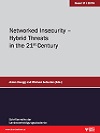Networked Insecurity - Hybrid Threats in the 21st Century
Dokumenttyp:
Schriftenreihe der LandesverteidigungsakademieErscheinungsdatum:
Juni 2016Herausgeber:
Oberst Dr. Anton Dengg, Mag. Michael SchurianVerlag:
Landesverteidigungsakademie (LVAk) / Institut für Friedenssicherung und Konfliktmanagement (IFK)ISBN:
978-3-903121-01-0Seiten:
385Autor(en):
Mag. Dr. Rastislav Báchora, Mag. Dr. Gerald Brettner-Messler, Christoph Cede, Oberst Dr. Anton Dengg, Prof. Dr. Michael Fredholm, Dipl Ing. Alfred Gulder, Mag. Reinmar Nindler, Mag. Dr. Thomas Pankratz, MSc Herbert Saurugg, MMag. Paul Schliefsteiner, Mag. Michael Schurian, Mag. Martin Staudinger, Mag. Ramy YoussefBeiträge in dieser Publikation:
Vorwort
The military, but ultimately non-violent taking of the Crimean peninsula by Russian special forces has demonstrated a novel threat phenomenon that was indeed theoretically conceivable in this form and yet seemed unrealisable politically. Here it is less about the individual components of "Operation Crimea” and more about their specific composition in defiance of the stipulations of international law and particular reliance on both old and new mass media. The resulting propaganda war, which continues to this day, makes it difficult for those involved and for observers to form a clear overview of what is actually going on or indeed of the causes and effects of events.
Many experts see Russia’s behaviour towards the Ukraine as confirming the hypothesis of hybrid warfare, which extends beyond direct and indirect military action also to include many other measures (including CyberWar),with a view to having an effect on the opponent and forcing his hand. Nor does this seem to be a new idea, given that the Chinese military theoretician Sun Tsu rated "victory without fighting” as the best strategy. Yet all of this falls short of covering the full bandwidth of risks, dangers and threats completely in today’s world with the means and possibilities available. To a certain extent, the associated profiles now manifesting themselves amount to a new form of "enclosure” of war, because both the aggressor and his target, as well as the actual objectives, can remain in the dark. Humanitarian international law and other international regulations may have no influence or be ignored, whilst the true extent of an "attack with modern means” on a state and its ability to function may only become recognisable at a very late stage and abruptly. Anton Dengg and the co-authors of this volume have dealt intensively with the topic of hybrid power projection in the context of a project. In this they progress beyond the narrow and indeed militarily dominated model of hybrid warfare to lay out a concept that endeavours to cover the full spectrum of threats. In doing this, they also accomplish pioneering work in the area of terminology, in that they define significant, relevant phenomena and point out that not every hacker attack constitutes a threat to a state, but rather that a strategic threshold, which must be defined by every state, has to be exceeded.It is evident from the contributions and country studies that a certain awareness of the problems arising from hybrid threats does indeed exist,and yet that perceptions and methods of resolution at a national level apparently tend to be diffuse or one-dimensional. The intention of the work presented here is therefore to make a contribution towards creating awareness,defining the problem and anticipating potential protective and countermeasures at a strategic level. Potentially particularly helpful in this regard is the graphic developed by Anton Dengg and Michael Schurian, which illustrates the spectra of threat potential. It should indeed also be seen as a prompt for forward-looking reflection.
Walter Feichtinger Director, IFK



